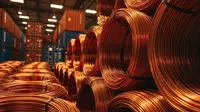High pressure experiments reproduce mineral structures 1,800 miles deep
27 Sep 2010
University of California, Berkeley, and Yale University scientists have recreated the tremendous pressures and high temperatures deep in the Earth to resolve a long-standing puzzle: why some seismic waves travel faster than others through the boundary between the solid mantle and fluid outer core.
 Below the earth's crust stretches an approximately 1,800-mile-thick mantle composed mostly of a mineral called magnesium silicate perovskite (MgSiO3). Below this depth, the pressures are so high that perovskite is compressed into a phase known as post-perovskite, which comprises a layer 125 miles thick at the core-mantle boundary. Below that lies the earth's iron-nickel core.
Below the earth's crust stretches an approximately 1,800-mile-thick mantle composed mostly of a mineral called magnesium silicate perovskite (MgSiO3). Below this depth, the pressures are so high that perovskite is compressed into a phase known as post-perovskite, which comprises a layer 125 miles thick at the core-mantle boundary. Below that lies the earth's iron-nickel core.
Understanding the physics of post-perovskite, and therefore the physics of the core-mantle boundary, has proven tough because of the difficulty of recreating the extreme pressure and temperature at such depths.
The researchers, led by Yale post-doctoral fellow Lowell Miyagi, a former UC Berkeley graduate student, used a diamond-anvil cell to compress an MgSiO3 glass to nearly 1.4 million times atmospheric pressure and heated it to 3,500 Kelvin (more than 3,000 degrees Celsius, or nearly 6,000 degrees Fahrenheit) to create a tiny rock of post-perovskite.
They then further compressed this to 2 million times atmospheric pressure and zapped the substance with an intense X-ray beam from the Advanced Light Source (ALS) at Lawrence Berkeley National Laboratory to obtain a diffraction picture that reveals the deformation behavior of post-perovskite.
They found that the orientation of post-perovskite's crystals in the deformed rock allowed some seismic waves - those polarized parallel to the core-mantle boundary - to travel faster than those polarized perpendicular to it. This anisotropic structure may explain the observations of seismologists using seismic waves to probe the earth's interior.






















